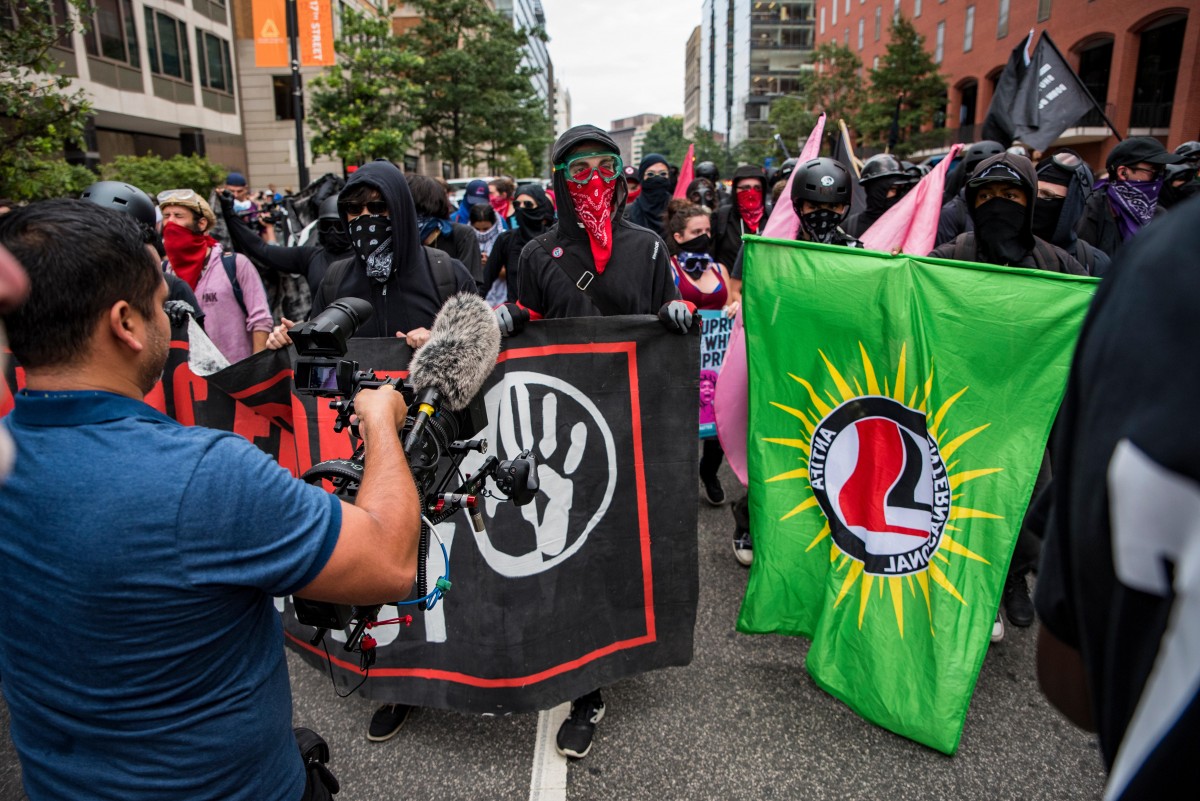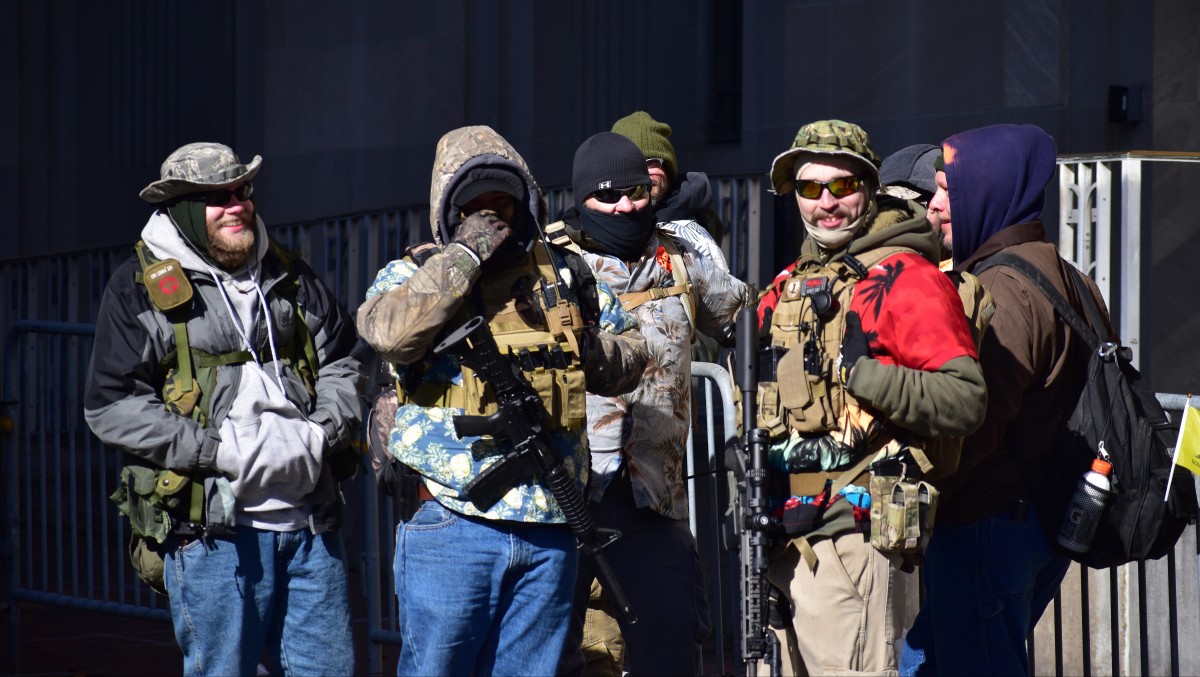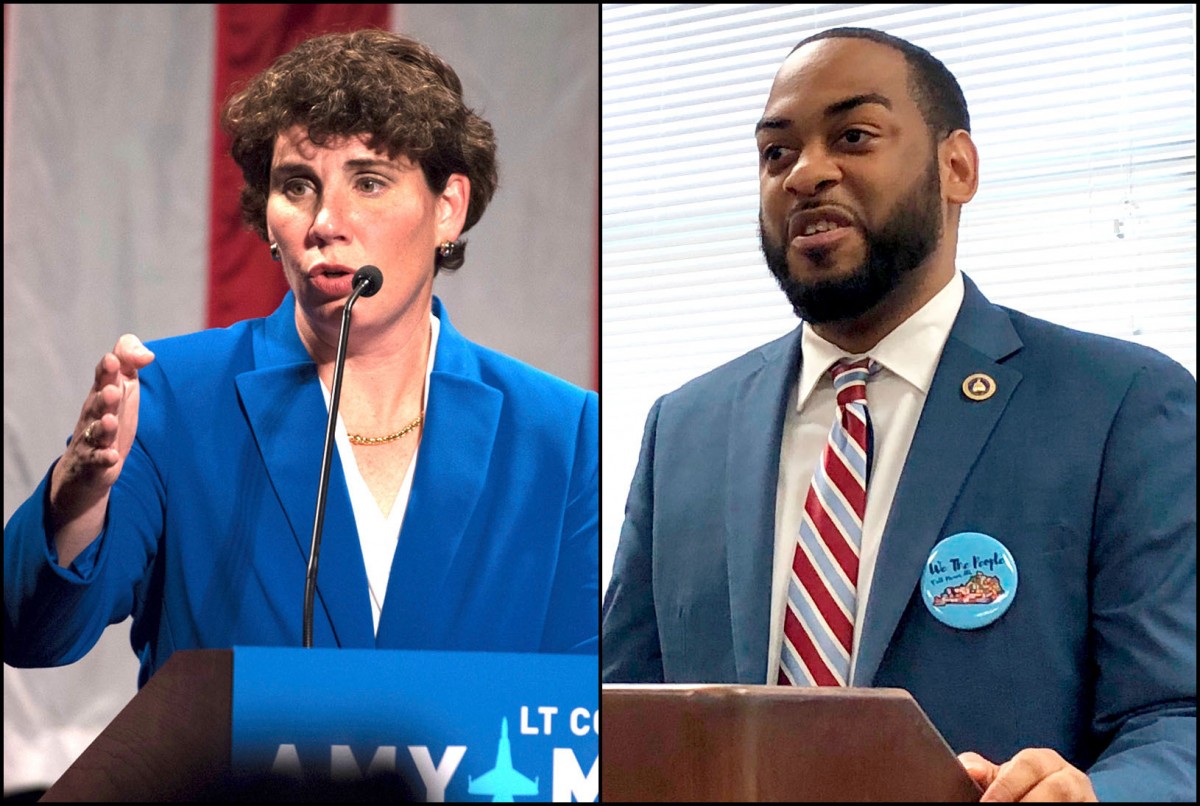It’s been a month since protests, rallies and marches erupted in the streets of American cities and Appalachian communities to demand an end to police brutality and reforms to our criminal justice system. Not long after the demonstrations began, authorities began to use the term “outside agitators” to explain how some protests turned into rioting, looting and destruction. The use of “outside agitators” is a long-standing trope used throughout modern history by politicians, dictators, management in labor disputes and notably by Southern white supremacists during the civil rights movements of the 20th century to dismiss legitimate opposition movements. This time, two groups emerged in the forefront of national conversations about the identity and motives of protesters.
President Donald Trump tweeted on May 31 that his administration would, “be designating ANTIFA as a Terrorist Organization”, quickly followed by Attorney General William Barr declaring that the Department of Justice considered violence and destruction caused during protests in Minneapolis to be “domestic terrorism”, attributing it to antifa and “other” extremists.
The day before Trump called antifa terrorists, the FBI arrested three heavily armed military veterans in Las Vegas as they prepared to incite violence at a Black Lives Matter protest. The men belonged to the “boogaloo bois” community, which researchers and investigators had been describing for months as a close descendant of other right wing extremist groups that openly encouraged violence against the government.
But descriptions of antifa and the boogaloo community as organized groups focused exclusively on enacting terrorism on American soil leave out an important detail: simply put, they don’t exist. Not by any metric used to define “terrorist groups” by the US government, at least. Neither have an established hierarchical structure, and as of this article’s publishing, no one has ever been charged with or convicted of a terrorist act on behalf of antifa. The same can’t be said for the boogaloo community — at least five people have been charged with terrorism explicitly related to the boogaloo movement — but their their actions were not ordered by other boogaloo community members.
Because of, or perhaps in spite of, this lack of organizational structure, antifa and the boogaloo bois do exhibit some surface-level similarities. Both are reactionary political communities, extreme subsets of the greater partisan divide across America. Both lack a coherent ideological stance or platform and are more defined by those who watch them – especially national media outlets – than by their adherents.
Online, one is most likely to come across antifa and the boogaloo community through the fire hose of memes and social media content they produce. The well-documented role of social media in bringing together anonymous, like-minded users has helped create the myth of these two as organized entities — and has helped draw people into the most polarizing ends of American politics. A twitter account called New York City Antifa has over 50,000 followers, while one of the main boogaloo Facebook groups has over thirty thousand active followers. With such a large followings, one would be forgiven for thinking that these accounts officially represent those movements, but the New York antifa page is used by a group of local researchers and activists, not the headquarters of any official antifa chapter. The boogaloo page’s administrators are quick to distance themselves from any notion of leadership or command over their followers in comments, especially in response to media portrayals of their community as an organized entity.
When both antifa and boogaloo materialize in real-world action, rather than legions of like-minded followers, they are almost always ad hoc, localized groups of private citizens who’ve chosen to adopt a name that helps them quickly identify ideological friends from foe, real and imagined. Both have evolved from ideologically driven movements of previous decades, and are in many ways not a new politically extreme phenomenon as much as they are the newest model of forces that have existed in America since its inception.
Antifa and the boogaloo bois have become the violent embodiment of America’s deeply partisan politics, with conservatives decrying antifa, and liberals and progressives arguing that the boogaloo phenomenon is nothing more than the KKK with better memes. But directly comparing the two by a surface deep look at their structural similarities might suggest they’re somehow equitable, representing two sides of the same coin. A deeper look into the origins and actions of both reveal how incomparable they truly are.
Listen to an interview between Chris Jones and West Virginia Public Broadcasting’s Dave Mistich, which originally aired on WVPB’s show West Virginia Morning.
Antifa

The term “antifa” originated during the Spanish Civil War as the catch-all word for various anti-fascist elements who allied to fight against the Nazi Germany-supported Franco fascist regime that overthrew a democratically elected government in 1936. (In fact, about three thousand Americans, known as the Abraham Lincoln Brigades, joined more than 40,000 volunteers who fought for Spanish democracy). The term largely fell out of common parlance for decades after the civil war ended, in no small part due to the fact that the entire world banded together to defeat three fascist countries – Germany, Italy and Japan. There was no need to call any group “antifa” when the entire world was anti-fascist by default.
The word returned to American tongues in the 1980s, when groups of left wing and anarchists came together to fight neo-Nazi skinhead groups in the Midwest. One of the most influential and largest antifa groups in the 1990s was a group called Anti-Racist Action that emphasized “action” due to a singular desire to work with anyone willing to oppose white supremacists on the streets, with little interest in ones politics beyond the issue. ARA groups were made up of a variety of ideologies: anarchists, anti-racist skinheads, and often times simply local residents who didn’t want white supremacists in their communities – a sentiment visibly on display during the Charlottesville counter protest against a white nationalist rally decades later.
During the 2016 election cycle and the ascension of Donald Trump, public displays of racism and fascist rhetoric that had caused the 1980s antifa movement emerged once again. Groups of left-wing and anti-racist activists who felt that “alt-right” ideologues like Ben Shapiro and Milo Yiannopoulos were encouraging and promoting racism and fascism during speaking events began attacking their events and supporters. Proud Boys — white nationalists who enjoyed publicly scuffling with antifa — resumed the role of the 1980s skinheads, and videos and articles of running street battles between Proud Boys and groups of local antifa made headlines again.
Antifa became a household name after a 2017 white nationalist rally in Charlottesville was opposed by a massive coalition of counter protestors, who ranged from avowed anarchists to non-political Charlottesville residents moved to action against a white nationalist rally in their hometown.
In Minneapolis and other cities where large-scale demonstrations against police brutality have arisen, destruction of commercial and government property – as well as an explosion of graffiti – has become the backdrop against which the Black Lives Matter movement has marched peacefully onward.
Some, including Attorney General William Barr, have suggested that this is the work of antifa. The accusation by mayors, governors and police chiefs across the country that these incidents are the work of “outside agitators,” people coming into cities with the intention of damaging property and inciting violence, has been used as further proof of antifa’s nefarious plotting. Yet there remains little to no evidence to support these claims. For example, a Reuters investigation of arrest records relating to demonstrations in Minneapolis showed that most of the individuals involved in property destruction were in fact locals. The same is true in Seattle. And Atlanta. And Cleveland, as well as dozens of other cities across the country.
According to Mark Pitcavage, a senior research fellow for the Anti-Defamation League, the absence of evidence of a wave of organized terror by antifa is not a product of their superior ability to evade detection by law enforcement – it’s because they don’t actually exist.
During a phone interview, Pitcavage explained up front that, “antifa is not a group, period.” With the exception of local activists who coordinate antifa action against white supremacists, “the way you identify as antifa is to simply show up at a white supremacist event to confront people, and then you go back to doing whatever else you were doing.”
While antifa action is basically defined by the use of violence against white supremacists, “they’ve never committed a terrorist attack, they’ve never murdered anybody. They have assaulted people, sometimes viciously, and they do engage in bad and counterproductive tactics, but they’re not a terrorist group or anything like that,” Pitcavage said.
Much of the activity that is being attributed to antifa is far more consistent with anarchist activity at protests, specifically the destruction of corporate or government property.
“In Minneapolis, if you look at the graffiti on any flat surface, there’s tons of anarchist graffiti,” Pitcavage said. “Now, a few people with a lot of spray paint can do a lot of tagging.”
While committed anarchists participate in antifa actions, they shouldn’t be confused for one another. “There’s more of an anarchist presence than an antifa presence, but most of the violence just seems to have been done by local people,” Pitcavage noted.
According to Pitcavage’s research, antifa “haven’t played a big role in the George Floyd related protests.”
“Because of all the different groups and movements that have participated in some of these protests, I’m sure there have been people among them who have also participated in antifa action,” he said. “[But] there’s no organized antifa presence at these protests. It’s not really their thing, as opposed to organized anarchist presence.”
Boogaloo
As the White House and law enforcement scramble for evidence of an organized and coordinated antifa, groups of armed private citizens affiliated with the title “boogaloo” and associated symbolism have assassinated police officers, attempted to conduct terrorist attacks in Las Vegas during rallies and have arrived in groups near demonstrations in cities across America – even here in Appalachia – in West Virginia, Ohio and elsewhere. Much like antifa, though, the “boogaloo” movement is not a united, organized group and is being largely misrepresented in media portrayals.
At community and city rallies across the country, some of these “boogaloo bois,” as they’ve call themselves, claim to be in support of the BLM movement and mass protest, though few have actually been documented marching with demonstrators. Others have stood in opposition to the BLM activists, defending Confederate monuments, the Alamo, businesses and homes from a nationwide protest that has overwhelmingly eschewed violence.
Not all of the armed groups that have shown up to BLM protests have been affiliated with the “boogaloo” community. Many have identified themselves as members of local militias – small local groups of armed private citizens who often espouse anti-government rhetoric and have been a major source of right-wing extremist violence for decades – while even more claim to simply be “libertarians.” In multiple incidents, these armed men have refused to give their names when interviewed by reporters, instead identifying themselves as some of the far right’s martyrs, many killed by law enforcement during shootouts and standoffs.
As explained in a recent NPR story, the exact origins of the word “boogaloo” are still debated, but its first widespread use in America was the name for a 1960s dance popularized by James Brown and other funk and soul musicians.
In 1984, the movie “Breakin’ 2: Electric Boogaloo” was widely panned by audiences and by all accounts was a commercial failure — though it developed a cult following and the term “boogaloo” became synonymous with an unnecessary, poorly executed sequel. In the same way, according to the Anti-Defamation League, “the boogaloo” has been used in anti-government and white supremacist online communities since 2018 as a term for what they consider to be an inevitable and impending second American civil war, one that would unquestionably also be unnecessary and poorly executed.
Though the spectrum of anti-government extremist groups in America are not all white supremacist in nature, they often share ideological fences, and the overlap makes them subject to scrutiny by law enforcement and anti-extremist organizations like the Southern Poverty Law Center, ADL and others.
Many anti-government online communities are extremely conscious of the U.S. government’s ability to track and intercept anyone’s online footprint. Militant pro-gun and anti-government online communities began generating memes and comments that poked fun at the idea that “boogaloo” could be a code word to avoid government surveillance. Many of these online communities make reference to “alphabet bois” and “steppers” (their preferred term for employees of the FBI, ATF and other acronym-ed law enforcement agencies) observing their discussions.
As soon as the term “boogaloo” gained prominence in public-facing online spaces earlier this year, commenters began suggesting the word was “compromised,” already known to law enforcement. Inventing new, seemingly innocuous variations of the term became a game played on subreddits, Facebook pages, Instagram memes, Discord chats and Telegram message threads. “Big igloo” became a popular alternative, hence the presence of igloos on flags and patches worn by “boogaloo bois” at demonstrations around the country today.
Selling Extremism: Hawaiian Shirts and Patches
One of the many subcultures created by the post-9/11 American fascination with the military is the “operator” aesthetic, a cosplay of Bradley Cooper’s portrayal of Chris Kyle in “American Sniper”: obsession with the bearded (almost exclusively white) male with body armor, AR style rifle, night vision goggles and a lifestyle devoted to owning and modifying guns designed for military warfare.
I legit want one of these patches. Those are great. pic.twitter.com/AwP4JtraBK
— Sophia (officially old) Narwitz (@SophNar0747) January 20, 2020
Successful businesses with names like Grunt Style, Article 15 and AAF (which stands for “American As F**k”) have risen out of this subculture to sell clothing, accessories and guns to its adherents. As ’80s culture enjoyed a revival in recent years, the iconic Hawaiian shirts popularized by Magnum PI became popular among young Americans embracing patriot-themed fashion and merchandise. Today, searching for “boogaloo patches” on Amazon leads to recommendations for Hawaiian shirts in the “you might like” section.
Back in the “boogaloo” part of the internet, “big luau” emerged as another boogaloo variant, and members of one prominent boogaloo online forum began posting photographs of themselves and their guns with Hawaiian shirts. The shirts, seemingly innocuous, were a nod to the “big luau” (and a wink to the “boogaloo”) and their cavalier attitude toward the thought of armed confrontation with federal law enforcement agencies.
The same brands who’d capitalized on what some call the “tacticool” aesthetic were quick to offer their own loose-fitting, button-down patterned shirts, many with images of military grade weapons built into the patterns themselves. A recent investigation into this phenomenon revealed that at least 35 companies that manufacture firearms and tactical accessories have explicitly marketed their products towards the boogaloo aesthetic — with some business owners openly endorsing the community. One company, who used the name Boogaloo Tactical since 2010, has had to explicitly distance itself from extremists.
The Boogaloo Go Public

In January, an anti-gun control rally in Virginia was the first time the boogaloo community ventured into public perception — pro-gun demonstrators wore patches with “Boogaloo Boys, Memetic 1st Warfare” on a scroll around a picture of the Pepe frog armed with an MP-5 submachine gun. The Pepe frog meme began as one of many meme formats in the early 2010s, but it quickly became used primarily by the growing alt-right for racist memes, as well as for trolling journalists who were covering their activities. Today, it’s almost exclusively used by anti-government and white supremacist groups.
Only two months later, Trump supporters and the spectrum of anti-government communities were driven to a frenzy by COVID-19 shut downs and a president who suggested some states required “liberation.” At an anti-lockdown rally in the state capital of Michigan, many of the demonstrators brought rifles and body armor. Hawaiian shirts began appearing under tan body armor at more and more demonstrations across the country, and media outlets began reporting in earnest on the once obscure community.
With the cat out of the proverbial bag, the term “boogaloo” — once a tongue-in-cheek reference to the idea of a messy second civil war — became a public symbol to display allegiance to an amorphous gun-loving and cop-hating community suddenly thrust into the public eye.
But then, on May 25, George Floyd was murdered by four Minneapolis police officers and the online boogaloo scene, previously untested but enjoying their first experience of journalistic scrutiny during the anti-lockdown demonstrations (as it provided ample chances to mock journalists who misreported minute aspects of the community and lumped them in with neo-Nazis and white supremacists), felt called to action.
Though the 111%er and militia community condemned the protests immediately, some self-styled “boogaloo bois” broke ranks with their anti-government ideological neighbors and publicly supported the anti-law enforcement stance of demonstrators. Fierce debates erupted on boogaloo Facebook and Reddit pages and forums around racism and homophobia within the community, with many moderators unequivocally claiming to reject racism and homophobia. In the comments below such posts, however, racist comments with hundreds of “likes” and “upvotes” made it clear that the boogaloo scene is hardly a united front against racism, homophobia, and anti-Semitism. It’s also worth noting that calls to distance the movement from its explicitly white nationalist roots were a result of critical public scrutiny, not a deeply held desire to purge the community of its highly visible racist supporters.
“This is a very embryonic movement, I wouldn’t even call it a movement if there was a better word for it. It’s not cohesive yet, it’s not fully formed, and it could fall away,” Mark Pitcavage explained. “There’s no guarantee that there will be boogalooers two years from now.”
Recently, many social media accounts and private groups associated with anti-government extremism have been purged, leading to many within the boogaloo community in search of a new home online. On July 29th, Reddit revised its Terms of Service and purged over 2,000 subreddits violating their ban on openly calling for violence and hate speech, including r/The_Donald which celebrated President Trump. The next day, Facebook banned over 500 groups, 106 of which were tied to the Boogaloo community.
Pitcavage is hesitant to put the boogalooers, as he calls them, on par with the two most well known categories of far right extremism; white supremacist groups and anti-government extremists like Soveirgn Citizens, militias, Oathkeepers and 111%ers.
Despite the internal debate about whether the boogaloo community is racist and anti-government or just anti-government, evidence of Hawaiian shirt-clad men with weapons at BLM protests show them standing alongside local militia groups at a much higher rate than they’re seen actively joining with protestors. This is not surprising, as many anti-government groups are made up of members of other groups, and the boundaries between them are extremely porous. For example, many militia members identify as 111%ers and Oathkeepers, though not all 111%ers are members of a militia. The boogaloo community has also followed in the militia tradition of constantly making reference to the murder of law enforcement in memes and posts online, but when a man in California wrote “I become boog” in his own blood on a stolen car after murdering two law enforcement officers, the “boogaloo bois” have been largely silent on the attacks, with others attempting to distance their community from his actions.
Boogaloo vs Antifa?
While some government officials and media outlets are quick to position antifa and right wing extremists like the “boogaloo” community as oppositional forces battling in America’s streets, little evidence suggests that there’s any merit to directly comparing the two. The specter of ideological vigilantes taking over urban streets certainly makes for a compelling headline to drive page views and ensure you don’t change the channel, and it’s an equally compelling narrative for those who wish to justify the deployment of the US military in America’s streets against peaceful protestors.
Antifa is demonstrably not the terrorist organization that the White House and U.S. Attorney General have accused them of being, and the boogaloo community is in some ways even less organized than the non-existent antifa. Antifa efforts can garner dozens, sometimes hundreds of people to show up to resist white supremacists, yet attempts to organize public gatherings of members of the “boogaloo” community rarely boast more than a handful of armed adherents, and are more often outnumbered by militia members, Oathkeepers, and 111%ers.
“Discussing them in the same breath puts them on an equivalent plane, which they’re not,” Pitcavage said. “Their tactics are bad,” he said, referring to antifa, “but not as bad as political opportunists have claimed. They’ve never committed an act of terrorism despite many attempts to describe them as terrorists.”
As for the boogaloo community, Pitcavage points out that they’re, “full fledged extremists, whether they’re anti-government or the white supremacists among them.”
“Their ideologies and belief systems are destructive and inherently violent,” he said. “In their very short life, as compared to antifa which has been around for decades, they actually have engaged in murder and terrorist acts.”
There is one similarity that Pitcavage acknowledged between the two groups: Both are broadly misunderstood by the general public. However, the reasons why both are misunderstood are drastically different.
“The ways in which the boogaloo are misunderstood are far more natural ways of being misunderstood,” in large part due to the fact that the movement is still so new and nebulous that a coherent central ideology has yet to emerge, “whereas antifa have been deliberately inaccurately portrayed for ideological and partisan purposes.”
“I really think it’s problematic to make a comparison,” he said, “because there’s an implicit suggestion that they’re opposite sides of the same coin.” But they’re not, as Pitcavage explained. Creating the impression that violent extremists from opposite ends of American politics are fighting one another plays directly into the idea that an impending civil war is imminent, a notion that a growing number of Americans are concerned about. More troubling is the growing evidence that the Department of Justice and Department of Homeland Security are more invested in chasing antifa boogeymen than countering right wing extremist violence – especially since the latter has proven to be the most likely demographic to commit terrorism on US soil since 9/11.
As we move closer towards a heavily contested presidential election, the risk of violence inspired by anti-government rhetoric will likely increase, though it remains to be seen whether the federal law enforcement agencies responsible for countering this danger will acknowledge the difference between those who rally under the antifa flag when white supremacists gather in their communities, and an internet culture whose adherents have already killed two police officers, wounded several others, and been caught attempting to commit mass violence across America.
Chris Jones is a Report for America corps member covering domestic extremism for 100 Days in Appalachia. Click here to help support his investigative reporting through the Ground Truth Project.



